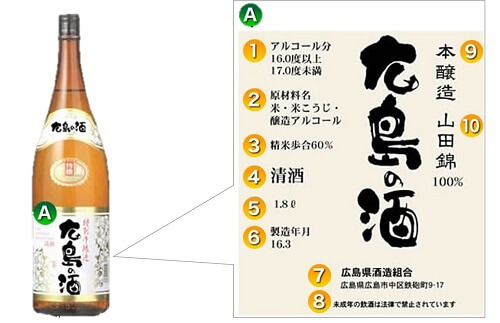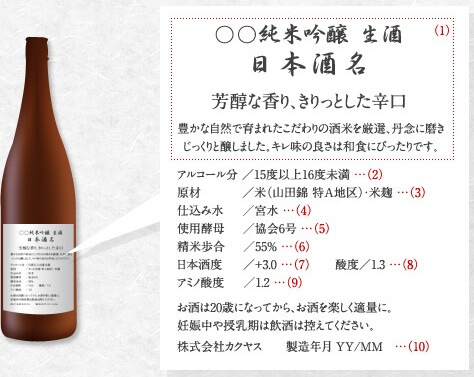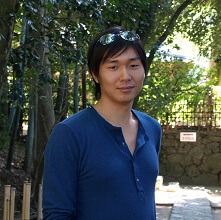Japanese Culture & Traditions
Japanese Sake 101
This page introduces basics of Japanese Sake.
Table of Contents
- What are Ingredients of Japanese Sake?
- Making Process of Japanese Sake
- Rank and Quality Standards of Japanese Sake
- Labels of Sake: What are Written and How to Read
- How to Drink and Storage
What are Ingredients of Japanese Sake?
Japanese Sake is made from rice, rice-malt and water.
Rice
The rice used for making Sake is different from rice for cooking. There are special species suitable for Japanese Sake.
Because surface of rice grains are ground off in its making process, remaining part “Shinpaku” is important for Sake. So, the “Shinpaku”, center part of rice grains of these species should be appropriate size and at the center of grain. One of the most famous species is “Yamada Nishiki” which is mainly produced in Hyogo Prefecture (where Kobe city is located).
Rice-malt
Rice malt which we call “Koji” is made by steaming rice, followed by getting them mouldy.
A specialized specie of mold “Aspergillus Oryzae” is used. This mold is chosen for making ingredient of Sake because a) it’s easy to be grown in the environment of Japan, b) it makes appropriate sweetness and taste for Sake, and c) it doesn’t be a poison… (it’s important!)
Water
Water is a most essential element to produce good Sake. 80% of Sake content is water.
Clean water is not enough for Sake. Water for Sake should be hard water which have abundant phosphorus, potassium and calcium. These minerals are necessary to ferment raw materials of Sake.
At the same time, water should NOT include too much iron because it gives bad color and smell to Sake.
Although there are a lot of places to get spring water in Japan, only a few of them are appropriate for making good Sake.
Making Process of Japanese Sake
Sake is made by fermenting rice which has been ground off their surface to remove the bran (referred as “polishing”). The mold “Aspergillus Oryzae” and Yeast fungus are added for fermenting.

After fermentation, raw unrefined Sake (we call it “Moromi”) is obtained. Squeezing Moromi, followed by storing (typically more than half a year) for maturation.
When Sake is completed, alcohol content is 15-16% typically. In present, however, there are various kinds of Sake and alcohol content also varies: some Sake are 6-8%, some others are 10-13% etc.
Rank and Quality Standards of Japanese Sake
Rank and name of Sake is determined based on how much rice surface are ground off (how much polishing have made), percentages of rice-malt “Koji” and ingredients.
Regarding special-designation Sake (these are typical Sake many people imagine), their ranks are determined like below.
| Special Designation | Ingredients | Rice Polishing Ratio | Percentage of Kōji rice |
|---|---|---|---|
| Junmai Daiginjō-shu (純米大吟醸酒, Pure rice Very Special brew) | Rice, Koji (rice-malt) | Below 50% | At least 15% |
| Daiginjō-shu (大吟醸酒, Very Special brew) | Rice, Koji, Distilled alcohol | Below 50% | At least 15% |
| Junmai Ginjō-shu (純米吟醸酒, Pure rice Special brew) | Rice, Koji | Below 60% | At least 15% |
| Ginjō-shu (吟醸酒, Special brew) | Rice, Koji, Distilled alcohol | Below 60% | At least 15% |
| Tokubetsu Junmai-shu (特別純米酒, Special Pure rice) | Rice, Koji | Below 60% or produced by special brewing method | At least 15% |
| Tokubetsu Honjōzō-shu (特別本醸造酒, Special Genuine brew) | Rice, Koji, Distilled alcohol | Below 60% or produced by special brewing method | At least 15% |
| Junmai-shu (純米酒, Pure rice) | Rice, Koji | Below 70% | At least 15% |
| Honjōzō-shu (本醸造酒, Genuine brew) | Rice, Koji, Distilled alcohol | Below 70% | At least 15% |
There are eight varieties for the “special-designation Sake”. The higher listed here, the better in taste and higher in price generally.
This kind of varieties and quality standards are defined by The Japanese Liquor Tax Act.
Labels of Sake: What are Written and How to Read
List of items that should be written in Sake labels are also regulated by The Japanese Liquor Tax Act. Items that are mandatory to be written are marked with * next to the numbering.
Typically, labels are attached both in front side and back side of a Sake bottle.
Front Label

(0)* Name of product – generally wiritten in the largest letter
(1)* Alcohol content by percentage (%)
(2)* Ingredients
(3)* Polishing ratio by percentage (%) – in case it says 60%, then 40% of rice surfaces are ground off by polishing.
(4)* Type of product – basically this just means “Japanese Sake”
(5)* Content quantity – typically in milliliter (ml) or in litter (l).
(6)* Date of production
(7)* Name and address of producer
(8)* Alert to prohibiting minors (under 20 years old in Japan) from drinking alcohols.
(9)* Special Designation – see above for Sake ranks
(10) Specie of rice as an ingredient
Back Label

(1) Production name, Brand, Special Designation and description
(2) Alcohol content by percentage (%)
(3) Ingredients
(4) Name of water as an ingredient
(5) Type/name of mold added
(6) Polishing ratio by percentage (%)
(7)-(9) Taste (sweet, hot, type of scent etc.)
(10) Date of production
How to Drink and Storage
Storage
In general, Sake hates high temperature, direct sunlight and oxygen. So, it is better to keep Sake refrigerated in a cool or dark room. Exposure to high temperature and/or direct sunlight will lead to spoilage of its taste and color.
Although Sake doesn’t have expiration date (date limit of freshness), it is better to drink as soon as possible once opened.
Best temperature to drink
Sake is a rare alcoholic drink which is enjoyable from cold temperature to relatively high temperature.
You can enjoy it from refrigerator-level temperature (approx. 5 degrees Celsius) to as high as 55 degrees Celsius / 131 degrees Fahrenheit.
Therefore, you can enjoy in whatever you like. In Japan, Sake is served chilled, at a room temperature, or heated (a bit higher temperature than shower), depending on personal preferences, qualities of the Sake, and the season. A famous classic says, just FYI, the best temperature of Sake should be slightly higher than body temperature…
Although we don’t have Sake products in our online shop, our office is located to just close to Sake Brewery Street in Nishinomiya city (Please see Related Post below).
Hope you enjoyed!
Related Post

Author - Hiro
Lived in Kyoto in school days, I was impressed by profundity of history and tradition of the city. Had a job to join the three major festivals of Kyoto: Aoi, Jidai and Gion festivals. Love Kyoto and Japanese culture.
Manager of OrientalSouls.com, selling items of Japanese culture, tradition and craftsmanship. I'll introduce interesting information about Japan!


About Orientalsouls.com
Learn and Buy Japanese Craftsmanship, Tradition & Culture
OrientalSoul.com is the online shop where you can buy traditional crafts of Japan.
We only sell selected authentic products in which true spirits of Japanese craftsmanship exist.
You may be able to find similar products in other shops for lower prices. However, we sell products based on fair prices that worth labor and value of experienced craftsmen.
In addition, we introduce stories about product history, how a product is made, what makes it different from others, and how the product enriches your life!